
Avalere Report: Exchanges Include 34% Fewer Providers
A report released by the healthcare research group Avalere Health claims that health insurance exchanges have a significantly narrow network compared with their commercial counterparts.
A report released by the healthcare research group Avalere Health claims that health insurance exchanges have a significantly narrow network compared with their commercial counterparts. The average provider networks, the report says, for plans offered on the health insurance exchanges created by the Affordable Care Act (ACA) include 34% fewer providers than the average commercial plan offered outside the exchange.
While it was
For this study, Avalere included the following 5 states: Florida, California, Texas, Georgia, and North Carolina. In these top 5 enrollment regions, Avalere compared the average number of providers included, for 5 provider types in exchange networks compared to commercial networks in the same geographic area. Commercial network data included plans offered in the group and individual markets outside the exchange. The analysis showed that the exchange plans offer the following number of in-network providers as a percentage of those offered on commercial plans:
- 68% primary care
- 76% hospitals
- 68% mental health
- 58% oncology
- 58% cardiology.
“Patients should evaluate a plan’s provider network when picking insurance on the exchange,” said Elizabeth Carpenter, vice president at Avalere. “Out-of-network care does not accrue toward out-of-pocket maximums, leaving consumers vulnerable to high costs if they seek care from a provider not included in their plan’s network.”
While narrow network plans face dissatisfaction on the provider and consumer end,
Newsletter
Stay ahead of policy, cost, and value—subscribe to AJMC for expert insights at the intersection of clinical care and health economics.








































